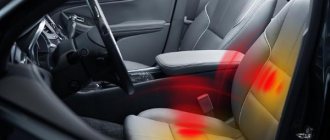Purpose
The purpose of a car heater, in other words, a “stove,” is clear to everyone - this device is designed to maintain heat in the car interior. However, the functions of the heater are somewhat broader - in addition to comfort, the heater is needed to prevent the car windows from fogging up. This situation arises not only in winter, but also in spring and autumn, when the task of the stove is reduced only to solving this kind of problem.
How to prepare for cold weather
In order to avoid the fact that the heating system in your car does not work in winter, it is important to prepare in advance for the cold season. If this is not done, the following problems may arise:
- insufficient amount of antifreeze - in this case there simply won’t be enough coolant and it won’t get into the radiator;
- accumulated air pockets in the heating system - heating will be insufficient due to impaired circulation;
- clogged air filter and/or fan - the filter must be changed on time, and the fan must be checked and regularly cleaned of dust and dirt;
- dirty radiator - dust and dirt will not allow it to fully heat the coolant;
- faulty air duct curtains - they must work fully so that warm air flows are blown in all the right directions, including onto frozen windows.
Important! Some of these points can be checked and corrected yourself (for example, change antifreeze), but it is best to contact a car service center before the cold weather begins.
History of appearance
Before the advent of automobile heaters, ordinary stoves and gas lamps were installed in cars. The first autonomously heated cabins appeared in 1917 on American cars. The cabin was then heated from the exhaust pipe. For example, a 1929 Ford A was heated this way. Also, to heat the interior, an additional radiator and a fan were installed to blow it around. This heating system was first used on General Motors cars. Gradually, it was this heating scheme that found development throughout the world.
In the USSR, car owners, in order to avoid freezing, made holes in the partition between the cab and the engine compartment. This helped them in the most severe frost.
Modern cars are heated using engine coolant.
Operating principle of a car heater
In the history of the car, there were even such types of interior heating as compact coal and wood stoves, and gas lamps. Later, exhaust gases were used for heating. Automakers have practically abandoned water-based interior heating, which was used in some models of passenger buses. Heated water circulating through pipelines under the seats and on the walls of the cabin quickly cooled, and the heating system had low efficiency.
Modern heating systems primarily use engine coolant to heat the interior using heated and filtered atmospheric air. A fan is used for forced air intake. The air is heated by the heat transfer of a running automobile engine, the intensity of its supply is regulated manually or automatically.
A normally functioning car heater, which drivers simply call a “stove,” heats the air in the cabin to 20–25 degrees Celsius in winter. An additional function of a car heater is to warm up foggy or frozen car windows and defrost frozen windshield wipers.
Principle of operation
The design of the stove consists of a radiator, pipes for coolant circulation, a fluid flow regulator, air ducts, dampers, and a fan.
Behind the front panel there is a heater core. Two tubes are connected to it, through which coolant flows into the radiator. This fluid circulates using a pump (a special pump) through both the engine cooling system and the car's heating system.
When the engine heats up, heat exchange occurs. Antifreeze cools the engine by removing heat from it. Hot antifreeze enters the heater radiator. The radiator heats up like a regular battery. At this time, the stove fan drives cold air through the radiator. Heat exchange occurs again: the radiator gives off heat to the air, and the air cools the radiator. Warm air blows into the cabin, and the cooled antifreeze ends up back in the engine and cools it. This heating system is the most common and efficient.
In order for the interior to warm up in winter, it should be about 30 degrees at the outlet of the stove. This temperature will not only warm up the interior well, but will also prevent the windows from fogging up. The airflow position switch, located on the dashboard, adjusts the position of the dampers. They direct air flows in a certain direction: face, legs, windshield. The direction of flow to the windshield is necessary almost constantly. This is necessary so that excess pressure is created in the cabin. At this pressure, the windows will not fog up, and dirt and dust will not get into the cabin.
The stove is an additional radiator. If the car is not warmed up, then when the heater is turned on, additional cooling of the system occurs. Because of this, rust appears on the walls of the radiator, and the engine takes longer to warm up. In addition, air humidity increases, and windows sweat. Therefore, the stove must be turned on when the coolant has warmed up to at least 50 degrees.
Heating systems for warming up the interior
Regardless of the type of heating system installed in a car, the engine is always the source of heat. When it is warmed up and started, it can also provide heating to the interior.
The interior heating process in most vehicles occurs as follows:
- The coolant enters the radiator where it heats up.
- The fan supplies air to the radiator.
- Warm air is already entering the cabin.
Different car models may have the following heating systems - climate control systems (programmable electronic or manual), mechanical “stoves” with manual control.
Note! Not all cars create heating by supplying coolant to the radiator. For example, electric cars lack both an internal combustion engine and antifreeze. Such cars have built-in electric heaters, most often ceramic. There are also cars with gasoline stoves (the same Zaporozhets), heat pumps with intermediate gas injection (Toyota Prius Plug-In Hybrid), viscous heaters (Land Cruiser 125, northern configuration).
Types of heaters
Along with liquid heaters, there are also liquid electric heaters and air heaters. They are used as additional heaters.
Liquid electric heaters use electrical energy. This heater resembles an ordinary boiler. But there are also more complicated models. They include a battery charger and a timer. The main disadvantage of such devices is their dependence on the electrical network.
The operating principle of air heaters is similar to the operation of liquid heaters. Only they heat not the liquid, but the air itself. These devices only heat the cabins, they do not heat the engine. Their advantage is lower fuel consumption.
Additional electric heater for vehicle interior
This is probably the simplest group among all similar devices. These devices are connected to the cigarette lighter socket, and this element is often installed on the front panel. Young drivers love these units for their affordable price. More experienced people try to use these devices in rare cases - as a hair dryer to warm up glass.
Among the advantages are the affordable price and ease of installation. There is no need to involve specialists for installation. This equipment is powered either from a battery or from a generator. The device can be used immediately after switching on. Its discreet shape, neutral appearance and equally neutral colors will allow it to fit into any salon.
Among the disadvantages, there is a large number of counterfeit products on the market - a suspiciously cheap additional interior heater can be downright dangerous. If you use it at full power, you can quickly discharge the battery - it is not recommended to use the device if the engine is not running.
Also, this group of equipment can negatively affect the wiring in the car. In addition, many argue that electric additional heating does not have high heat transfer.
Four problems with the stove: diagnosing it yourself
“Behind the Wheel” experts explain how to assess the nature of the malfunction - this will protect you from unnecessary expenses during repairs.
The source of heat in a car is the engine (electric cars do not count). Its operating temperature is about 80–90 degrees. Excess heat is removed through the radiator, but with the arrival of cold weather, part of this heat is used to heat the interior.
The process usually looks like this. The heater receives air - external air or, if the recirculation mode is turned on, internal air. It passes through the cabin filter, the air conditioner evaporator (if equipped), and then either through the heater radiator or past it, depending on the driver’s desire. Then, with the help of dampers, the air is directed to certain areas: on the glass, in the face or in the legs.
We figured out the design. Now let’s talk about the main reasons why a seemingly simple system can go on strike.
Features of climate control operation
If your car is equipped with climate control, then all the procedures for optimizing the heating of the interior will be done by the computer for you. You need to set the desired temperature in the cabin and select the “auto” mode. The climate control controller will select the fastest option to achieve the goal, based on data from temperature sensors. However, the operation of climate control in a car in winter sometimes requires adjustment. The fact is that the program of this device provides for the creation of comfortable conditions inside the car. In this case, warm air is distributed evenly throughout the entire space. If you need to concentrate the flow, for example, on the windshield, you will have to abandon the services of a computer and switch to manual control. In this case, you need to select the blowing direction and fan rotation speed. After the glass freezes, you can return to automatic mode again.
Premium cars and large SUVs are often equipped with multi-zone climate control systems. In the case of three-zone control, the computer is able to separately control temperature conditions in the following zones:
- driver's workplace;
- front passenger space;
- rear seats.
Zoning options may be different; it depends on the manufacturer’s design, and in executive class cars, on the wishes of the customer. With this configuration, you can set the desired temperature in each spatial area separately.
Four-zone climate control
See also:
The smell of gasoline in the car interior: causes and elimination
Equipment installed additionally
What should an unlucky driver do who does not want to waste precious time warming up the interior, but at the same time wants to drive in comfortable temperature conditions? Of course, there is a way out. And not alone.
- Fuel pre-heater. This device is installed under the hood of the car. To generate heat, the same fuel is used on which the car's power plant runs. It is turned on before starting the engine. On premium cars, a preheater is often included as standard. Its use allows you to warm up not only the engine, but also the interior of the car in a matter of minutes.
Engine preheater
- Electric preheater. The principle of its operation is very simple. A heating element is placed in the water jacket or in the crankcase, which must receive power from a stationary 220 V network. Before starting, the device is briefly connected to the network. Working fluids are heated to certain temperatures, which allows you to quickly start the engine and supply hot antifreeze to the heat exchanger of the interior heater.
- Remote start. Some car alarm models provide the ability to remotely start the engine. This saves a lot of time, especially if you live in an apartment building and your car is parked outside your windows. While you finish your morning coffee, your car is warming up. Sitting in a warm, cozy cabin is much more pleasant than chattering your teeth in a cold car.
There is also a simple and cheap old method. Buy a fan heater at the car market that operates from the car’s on-board network. After starting the engine, when the generator begins to fully charge, turn it on through the cigarette lighter connector and let it run for a while. Fans with ceramic heating elements are considered the safest. After the standard heating system begins to function, the “blower” can be turned off.
The warm interior of your car is not only comfortable movement, but also safe driving in the conditions of long domestic winters. Don't forget about your health and the health of your passengers.
1 comment
- Pavlukha says:
According to statistical data, the most important achievement in car development over the past 5 years is the BUTT! And by a considerable margin. And I completely agree with this result. WHAT could be better than jumping into the cabin from the cold and immediately warming up the lower brain... And what other heating of the car interior can there be in winter? Turned on the stove, sipped some tea and off we went.
Autonomous heating
In most cases, these stoves are installed on minivans, minibuses, campervans or trucks. The heater is powered by fuel. The system has a separate independent combustion chamber and a pipe for exhaust gases.
Installation of an additional interior heater is only possible in the engine compartment. The device operates independently of the engine, which is why it is called autonomous.
Some of the positive characteristics include independence from engine heating, the ability to adjust their interior, the absence of unnecessary parts in the interior, and readiness for work immediately after starting. And unlike hair dryers, the equipment is quite efficient, transfers heat well and has high power.
But there are no downsides - installation is much more complicated compared to installing a hair dryer. If you want warmth in the cabin, you will have to pay a little more for gasoline - the device increases consumption. The cost of ownership is higher than that of a hair dryer. Well, in addition, this additional car interior heater makes a lot of noise when operating.
As for the device, it is a metal cylinder that houses the combustion chamber and electronics.
The latter controls the process. The system is connected to the fuel pump, equipped with a combined temperature control unit,
This is hell! We measure the inferno and check how to escape from it
Have you heard the story of how a Kobrin resident’s yogurt exploded in his car? No wonder! In direct sunlight, the interior warms up to +50°C, and in some places the temperature can exceed +85°C!
We know this for sure: on the very day when the unlucky motorist cleared his car of the remains of a biological bomb, we were in the process of measuring, armed with thermometers and a thermal imager, to what temperature the car interior warmed up under the sun. And at the same time, they checked how effective the recommendations for protection from heat that they themselves gave you two years ago were.
How they checked
To begin with, we waited for hot days. Then we asked ourselves the question of finding two identical cars, because we were going to make all the measurements in comparison. Thanks to the Skoda dealer, who responded to our request and promptly allocated two identical Octavias for our experiment. Both have a white bottom, a dark top (black roof and deep tinted rear windows), as well as climate control - so the technical conditions are equal.
What about the toolkit? It was decided to measure the temperature in the cabin using household alcohol thermometers. No matter how archaic they may look, it is believed that the error will be no more than 0.5–1 degrees, which suits us quite well. The only drawback is that the devices are inert; changes are reflected slowly, which in some cases was completely unimportant for us, but in others, on the contrary, it was fundamental.
Therefore, we armed ourselves with two more devices. One of them is a non-contact thermometer, which we used to accurately measure different areas of the cabin. The other is a thermal imager. It came into our possession at the very last moment and, first of all, we used it to clearly demonstrate how different the temperature in the cabin can be.
Despite the fact that both devices are considered very accurate, the second one is even verified, there are a number of nuances due to which we will inevitably receive measurement errors. For example, if you point the device at a person, it will show something around +33°C, although the temperature of a healthy human body fluctuates between +35.5...+37°C. How so?
All bodies emit radiation in the infrared range of electromagnetic waves. By measuring the power of this radiation, the surface temperature can be obtained. But, firstly, the temperature of the surface, say, the dashboard, is not the same as the air temperature in the cabin. Secondly, different bodies have different emissivities. In the thermal imager we set it at 0.95, which is not true for every surface. But in a thermometer, the coefficient is completely set by the manufacturer and remains unchanged.
But using three instruments allows you to take more measurements and, by comparing the results, arrive at the most correct value. In addition, we get additional opportunities. For example, spot temperature measurement in different areas of the cabin, which will really be excellent, especially on a summer day.
Open the windows!
First, let's check the recommendation to leave the car with the windows slightly open. It is believed that thanks to this, minimal ventilation is maintained in the cabin and it does not warm up so much. We leave both cars on the street with their sterns facing the sun (deeply tinted rear windows take the brunt of the sun's damage), while in one of the Octavias we lower all the windows a few centimeters down.
An hour later we take measurements. From the initial +28°C, the interior of the completely closed car warmed up well - there was an excellent steam room. The alcohol thermometer shows +40°C.
In the second car it is easier to breathe, so the temperature seems to be much lower. Although the thermometer shows +37°C, the difference of three degrees is quite small. But numbers are numbers, and subjectively, sitting in a cabin with “ventilation” is much more pleasant!
No way without a curtain!
Leaving a car in the sun, we get not only a very heated interior, but also a hot steering wheel, gear lever, and panel. The old-fashioned way to solve the problem is to place a towel on the panel. Or better yet, a special curtain - a screen with a mirror surface.
Using climate control systems, we cool the interiors of both cars to +25°C, turn them “facing” the sun and leave them to warm up again. At the same time, we install a sun screen in one of the cars. We know that there are definitely benefits from it. But what is it in numbers?
After an hour and a half, we take measurements. In a car with a curtain, the interior warmed up to +42°C - this is the temperature in the area of the center console and in the lower part of the front panel. The non-contact thermometer shows the same amount on the rim of the steering wheel. The upper part of the dashboard and the visor of the instrument panel warmed up a little more, to +53°C.
But all these are small things in comparison with the inferno that greeted us inside the second car! An alcohol thermometer is useless - the red bar is at the top of the scale, so the temperature inside is noticeably higher than +50°C.
Using a non-contact thermometer and a thermal imager, we are trying to create an overall picture of individual points. The lower part of the front panel is +54°С, the steering wheel is +55°С (we will take this temperature as the average), and the upper part of the dashboard is +78…+82°С!
The area around the driver's head also warmed up to almost +60°C, while in a car with a screen the measurements showed no more than +46°C. Thus, we can say that the use of a sun screen can reduce the temperature by 10–20 degrees (depending on the zone).
Does it depend on the color?
“Poking” non-contact thermometers into the hood or roof of cars of different colors, we get interesting numbers: on white – +39°C, on gray – +55°C, on black – +59°C! But this is exactly the case when the data is not entirely correct: surfaces of different colors have different emissivities, so the obtained figures require recalculation using the formula.
But does the interior of a dark car heat up more than a light one? We measured the temperature of a gray Octavia, standing on the same platform and also facing the sun. The temperature in the cabin is +55°C, that is, the same as in one of our cars parked against the sun without a curtain. It turns out there is no difference? Let's assume that the experiment was not clean, because the white car had a black roof, and that is what should attract the sun's rays!
Better in the shade
What if you cover not just the front panel, but the entire car from the sun? We cool the interiors again and leave one car in the sun, again placing its stern in the direct rays, and drive the second into the shade. We wait 40 minutes - at the height of a hot day this is more than enough to already get a significant difference in temperature.
This is true! The interior, left exposed to direct sunlight, instantly warmed up to +44°C, while inside the car left in the shade we only got +35°C.
Draft versus air conditioner
We have already said more than once that before getting into the car, it is better to ventilate the interior: open the windows, and even better, open the doors. By the way, how significant is the difference between these two options?
We bring the temperature in the car interiors to +39°C, open the windows in one, and open the doors in the other. After 10 minutes we get +37°C and +36°C, respectively. However, here we must make allowances for the inertness of alcohol thermometers and their location in the cabin. Subjectively, the temperature dropped noticeably more, especially in the second car. Weather conditions should also be taken into account. At the time of testing there was complete calm. In windy weather the effect would be greater.
By the way, what will happen if you cool the interior using an air conditioning system? Look at the picture taken with a thermal imager: the upper part of the dashboard is “blazing” (+50°C...+70°C), and cold air is pouring out of the deflectors (+15°C...+18°C). It is better not to fall under these currents; it is better to direct them away from you to the sides, so as not to receive a sharp dose of cold in the general heat.
However, no matter how you distribute or direct the flows, the climate system requires a certain time to cool the air to an acceptable level. But how can the driver and passengers “survive” until this moment? And wouldn’t it be better to hyperventilate before that by opening the windows/doors?
To answer this question, we conduct another experiment. Again we “warm up” the interiors to +39°C, then try to cool them down to +25°C in different ways. The first of them is to simply turn on the climate control, set the desired temperature and wait until the system switches to maintenance mode, that is, reduces the efficiency of the airflow. This took about 9 minutes.
Now let’s try to actively ventilate the interior: open all the windows and drive for three minutes with the climate system turned off at a speed of 10–15 km/h, as if we were leaving the parking lot or driving through the yard. After this, close the windows and also turn on the climate control in automatic mode, setting the value to +25°C.
In the second case, the fan slows down after just a couple of minutes of operation, and in total – at the 6th minute after the start of movement. That is, it is possible to cool the interior one and a half times faster. What’s even more important is that you can be inside the car from the very first minute, as soon as you open the windows and start driving.
Our verdict
We clearly showed how hot the interior can get in the sun. Moreover, it even depends on which side the machine is placed towards the luminary. If there is rear tinting, it is better to place the car in direct sunlight with its stern. The sunscreen provides a difference of 10–15 degrees, which is very significant, so the device is useful. It’s even better to park the car in the shade, preferably with the windows slightly open.
And after parking, hyperventilation will allow you to cool down the interior: open the doors for a couple of minutes, and do the first meters of the distance with the windows down - this way you will noticeably reduce the temperature in the cabin and help the climate system quickly reach the required value. Just remember that the difference between what is in the cabin and what is outside should not exceed 10 degrees!
Ivan KRISHKEVICH Photo by ABW.BY
PS The editors of ABW.BY would like to thank , the official Skoda dealer in Belarus, for the cars provided for testing.
How does engine preheating work?
Warming up of the engine is carried out by burning gasoline or diesel fuel from the standard fuel tank of the vehicle in the combustion chamber of the device. The equipment is mounted in the engine compartment and connected to the engine liquid cooling system.
Using a pump, fuel is pumped into the combustion chamber. In the combustion chamber, the fuel is ignited by a spark plug. The heated boiler releases heat to the coolant through a pump pumped into the device, which circulates the coolant throughout the engine cooling system.
The parameters of the sensors and timer are set from the control panel (the start and shutdown times of the equipment, temperature are set). If the car has a navigation system, it is possible to start the equipment via a mobile phone.
When the coolant warms up, you can use the remote control to turn on the standard heater fan, which will heat the interior when the driver arrives. The liquid system consumes about 0.5 liters of fuel per hour.
Disadvantage of the system
pros
Car heating system
The thin metal of a car body or truck cab instantly reacts to fluctuations in atmospheric temperature. In summer, the temperature in the cabin can rise to 40 - 50 degrees. In winter, the temperature in the cabin or cabin differs from the outside frost by 2-3 degrees. Drivers and passengers of vehicles escape from summer overheating by turning on the air conditioner or opening the windows. In winter, only the car's heating system can ensure a normal temperature in the cabin. In the climatic conditions of Russia, normal operation of a car heater is relevant for two thirds of the year.











